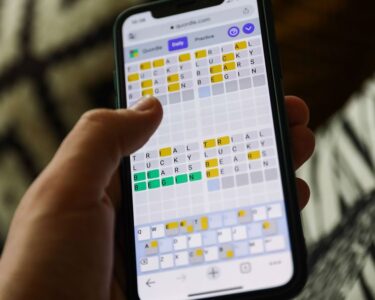When you think of getting tested for a disease, you might think first of nasal swabs, urine tests, blood draws. Even though around 1.8 billion people across the world menstruate, period blood doesn’t come to mind.
But that might soon change. Earlier this year, the U.S. Food and Drug Administration for the first time approved a health test based on period blood. The at-home test, which detects a biomarker for diabetes, offers an alternative to the blood draws typically required to diagnose the disease. It’s also a first step in a long-term vision for researcher Sara Naseri, CEO and cofounder of Qvin, the San Francisco Bay Area–based company that makes the test.
“Women bleed every month, so why let that go to waste?” Naseri remembers wondering a decade ago as a medical student. Period blood, she thought, could be a convenient way to get clues to a person’s health — no needles required. When she couldn’t find much research on the approach, she decided to look into it herself.
Then at Stanford University School of Medicine, she and her colleagues found that “menstrual blood is in fact blood,” she says, and “essential health information can be gleaned from it.”
That preliminary study, reported in 2019, compared samples of menstrual blood with blood that circulates through the body from 20 women over two months. The team concluded that menstrual blood could reliably estimate levels of several biomarkers — including for diabetes and inflammation — as well as reproductive hormones, and so could be an alternative source for diagnosis and health monitoring.
Since then, Naseri and colleagues have further tested menstrual blood for diabetes diagnosis specifically and studied whether types of human papillomavirus that put a person at a high risk for cervical cancer can be detected in the blood.
But anthropologist Kathryn Clancy says it’s too early to be rolling out products based on menstrual blood testing. She researches women’s health, endometrial function and evolutionary medicine at the University of Illinois Urbana–Champaign and is author of the book Period: The Real Story of Menstruation. “Menstrual blood is super interesting, but it looks like the only test that they’re able to do is A1C,” which measures average glucose levels in the blood. And that test, she points out, “is very easily done with a regular [blood] test.”
For now, Clancy would like to see more effort and money put into the still-nascent research, which is what will best serve people’s needs. At the same time, she’s intrigued by the idea of using menstrual blood for medical tests.
Testing for diabetes is a good place to start.
What is the Q-Pad?
Estimates suggest that almost 40 million people in the United States have diabetes, with just under 9 million of them undiagnosed. Many others have elevated blood sugar levels that fall just below where diabetes can be diagnosed and are unaware of it, says physician Kathleen Jordan, who specializes in women’s health care. She is chief medical officer of the telehealth provider Midi Health, based in Menlo Park, Calif.
Diabetes causes more than 100,000 deaths every year in the United States and about 1.5 million globally. Complications from diabetes include disorders of the eyes, kidneys, nervous system and heart, and increased risk of stroke, which can all be prevented with early diagnosis and treatment. “I think more people need to get tested, period,” Jordan says.
Diabetes is easy to diagnose using a hemoglobin A1C test, which reflects the average blood sugar level over the two to three months leading up to the test. It requires a blood draw by a trained technician but no fasting or other prep from the patient.
Qvin’s do-it-yourself option — called the Q-Pad test kit — has two special menstrual pads with removable collection strips. After collections during one menstrual cycle, both strips are mailed to a certified laboratory for testing. Results arrive via app or email.
“The reliability is excellent, and it correlates with serum blood testing,” Jordan says. There’s also a strong correlation between diabetes and polycystic ovary syndrome, or PCOS, which causes irregular periods and infertility. The A1C biomarker could aid in the diagnosis of both, Jordan says. “It offers a solution for people whose barrier to getting tested may be needle-phobia.”
There are some downsides though: At a cost of $49, the test might not be affordable for everyone. (It doesn’t require a prescription, but insurance doesn’t pay for it.) And its reported results are not yet integrated into existing medical records systems. Because it’s new, Jordan says, clinicians will probably retest with a traditional blood draw to confirm a diagnosis.
How does period blood differ from regular blood?
Doctors have been relying on blood tests to assess patients’ health for almost three quarters of a century. Today hundreds of biomarkers present in the blood offer a window into our well-being, from nutrient deficiencies to signs of cancer.
Menstrual effluent — the cells and tissue from the thickened endometrial lining of the uterus that are shed every cycle — is far more complex than blood from the veins or arteries. It does contain blood that you would get from a blood draw from other parts of the body, but it also has proteins, hormones and bacteria that are specific to the uterus. One study identified more than a thousand proteins in menstrual effluent. Of those, 385 are found exclusively in period blood and not in circulating blood or vaginal fluid.
And there may be other stuff we don’t fully know about, Clancy says. Research on menstrual blood, she says, is “so young that we’ve barely characterized everything that’s in it.”
What is the potential of period blood testing?
For now, the period blood test has been approved only for diabetes. But Naseri sees far greater potential. Her list includes testing for c-reactive protein, a marker for inflammation; reproductive hormones, which can signal fertility or menopause; thyroid hormones for clues to thyroid health; and even antibodies that indicate an immune response to SARS-CoV-2, the virus that causes COVID-19. All these markers are present and already tested for in circulating blood.
The extra components in period blood present additional opportunities. The same study that analyzed the proteins in menstrual blood also identified markers of uterine infertility. Detecting those markers would otherwise require uterine flushing, X-rays or other imaging tests. Cell populations in menstrual effluent could help diagnose endometriosis, which usually requires a physical exam, ultrasound, MRI and sometimes invasive procedures like a biopsy or even surgery. Similarly, types of human papillomavirus that come with a high risk of cervical cancer can be detected in period blood (versus the traditional pap smear).
A company called theblood, cofounded by entrepreneurs Miriam Santer and Isabelle Guenou in Germany, plans to develop a menstrual blood collection and testing product that would cover a wider array of health indicators, including biomarkers for PCOS, endometriosis and the early detection of cancer. It would also make health recommendations based on not just those biomarkers but also a person’s cycle, nutrition, lifestyle and any reported physical and mental symptoms. “More like a holistic health approach, but with a very specific blood analysis,” Santer says.
An early version of the product, called Zyklus-Check (Cycle-Check), that doesn’t yet include any biomarker analyses is on the market. It evaluates the color, viscosity and other physical properties of period blood, which the company claims “helps you to understand how to optimize your diet, exercise and lifestyle choices to increase your menstrual health and well-being.” Santer is hoping the requisite approvals and certifications for biomarker analyses come through by year-end.
“On the side, we’re [also] investing in research for novel biomarker detection,” Santer says, including conducting clinical studies that compare biomarkers, reproductive hormones and vitamins in menstrual versus circulating blood. Theblood is also exploring whether stem cells are present in period secretions.
What are the challenges?
One of the big challenges of using menstrual blood is that it hasn’t been tested and evaluated for diagnostics and therapeutics in the same way other blood has, Naseri and her colleagues pointed out in their 2019 study.
There’s a lot more basic science needed, Clancy says. One open question is whether any particular menstrual blood value represents a moment in time or some accumulation. How period blood might vary at different points during menses or between individuals has not been properly studied yet, she adds. (There are indications that biomarkers in circulating blood can also vary over the menstrual cycle.)
Another challenge is preventing the deterioration of menstrual effluent samples. Once blood contacts air, microbes start acting on it. Techniques have been developed to stabilize samples drawn from veins or arteries, but menstrual blood deteriorates faster.
The reason so many questions remain is simple, Santer says. “We’ve just not been focusing on women’s health in general…. There’s not enough basic understanding of the woman’s body, how we’re affected by specific diseases, how we react to medication, therapeutics and so on.”
It wasn’t until last year, for example, that period products such as cups, discs, pads and underwear were tested with actual blood (though not even menstrual blood) for the first time. The research studied the absorbency and red blood cell capacity of period products to better assess heavy menstrual bleeding.
“Speaking about menstruation openly is still taboo for a lot of people,” Santer says.





